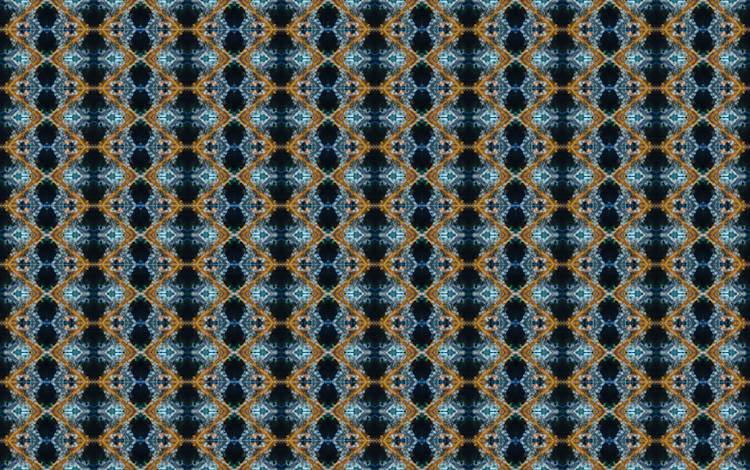
Design inspo: Remove your photo's background and add a new one that spans both halves for a mod look that breaks up the symmetry.
From the tastefully artsy to the weirdly symmetrical, mirror images are mesmerizing. And it makes sense. People have been captivated by their own reflections since long before Narcissus discovered his. What’s more mesmerizing than your own reflection?
Our answer? Your reflection, reflected back on itself again and again and again in an infinite pool of distortion. Check out this swift tutorial to see how to make mirror images that turn heads (literally). Here are the deets.
Horizontal flip

The horizontal mirror image works especially well with portraits or profiles. But do whatcha like — you can try it with flowers, pets, or donuts. Whether you upload a personal pic or use one of PicMonkey's stunning stock photos, here's what to do.
Open an image in the editor.
Go to Edits > Crop canvas to increase the size of your canvas to make room for the mirror image.
Duplicate your image by copy and pasting (right-click to copy, right-click to paste) or just right-click Duplicate layer.
Highlight one image and click the Flip horizontally arrows found on the very bottom of the left image toolbar (there are five small icons below the Comments option).
Position each image as you like, remove or replace the background, add text, do your thing to make it special.
Vertical flip

This is gonna look especially good with landscapes or any image with a horizontal span across, but again, feel free to play around.
Open an image in the editor.
Go to Edits > Crop canvas to increase the size of your canvas to make room for the mirror image.
Duplicate your image by right-clicking Duplicate layer.
Highlight one image and click the Flip vertically arrows found on the bottom of the left image toolbar (there are five small icons below the Comments option).
Position each image as you like, customize with effects or textures, or leave as is!
Double mirror

Why stop at a single mirror image when you can double it up? To get an image that’s reflected in quadrants, you'll need to work with four identical images. This works best with images that are already symmetrical.
Open an image in the editor.
Click Edit > Crop canvas to increase the size of your canvas, or use the blue handles to shrink your pic to 1/4 the size of the original canvas.
Duplicate your image by right-clicking Duplicate layer 3x.
Select one image and click the Flip vertically arrows on the left image toolbar. Repeat with horizontal and vertical flips.
Position each image as you like, customize with effects or textures, or leave as is!
Kaleidoscope

Ready for things to get really crazy? To get a super abstract or repeating pattern look, take that double mirror you made, group it into a single image, and go wild with as many flips and flattens as you like.
Truthfully, you can't go wrong with your stylistic choices here. And if it helps, you can explore these geometric design examples to spark a starting point. You can choose a simple pic to complex-ify, or you can start off with an already intricate photo and rev it up from there. The PicMonkey world is your oyster!
Why make mirror images?
Now that you've got the design inspo, you might be wondering, But why apply this snazzy feature? The simple answer is, well, why not?! But truthfully, mirror photos, while abstract, do have diverse and relevant applications.
Gone are the days spent researching the largest optical illusions in the Guinness Book of World Records. Now, you get to make your own right here!
Artsy
Whether you're making a flyer for your next art showing, creating standout Facebook pics, or offering professional design services, mirror pictures make folks do an immediate double-take.
You don't have to be artsy to get artsy. The truth is, in a world where employers spend only 6-7 seconds on a resume, it's important to find innovative ways to stand out. Being artsy, however, also means honoring that fine line between just enough and too much. Have fun and be creative, but have restraint if you're using mirror photos professionally.
Captivating
The unconscious (or subconscious) mind is responsible for gathering 11 million bits per second of data, whereas the conscious mind only gathers 50 bits per second. The "data" we process every second relies upon our sensory receptors.
Needless to say, even if someone saw your mirror image for a split second, it'd still get processed by their subconscious mind. Having a captivating image makes it scientifically more likely to be remembered. So that's cool.
And, given that near 65% of the population are visual learners, having a wow-factor image keeps folks engaged longer. Whether for personal or professional reasons, mastering the mirror picture can increase customer engagement across the board.
Unique
The jury's still out on whether or not it's possible to have too much of a good thing, but in the world of mirror images, we say bring it on. Whether you loved funhouse mirrors growing up or just appreciate abstraction, mirror photos show people things they otherwise wouldn't see. So go for it! Flip your photos up, down, and all-around. You never know what you might discover.
